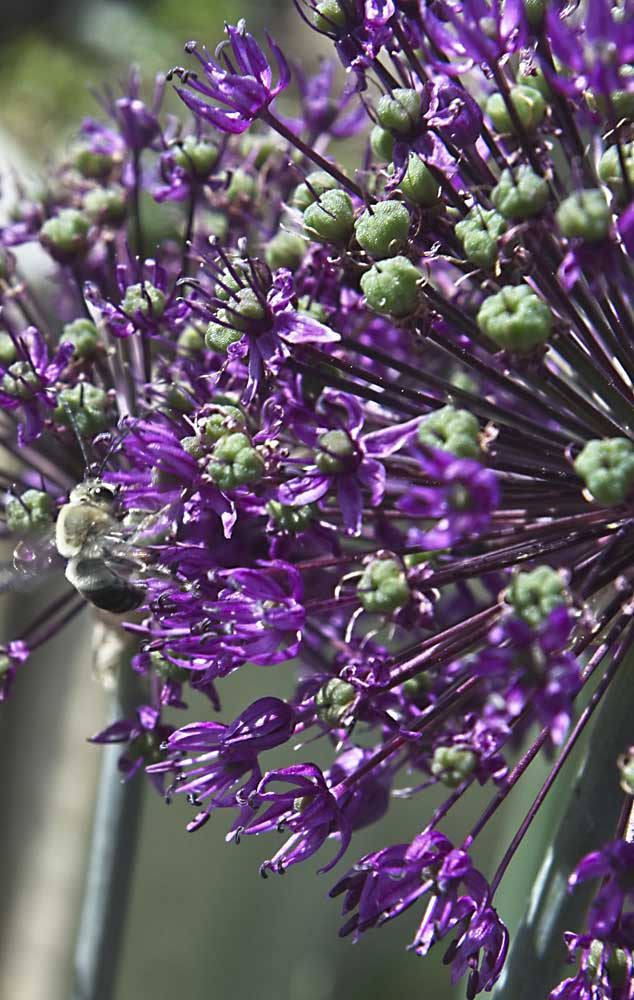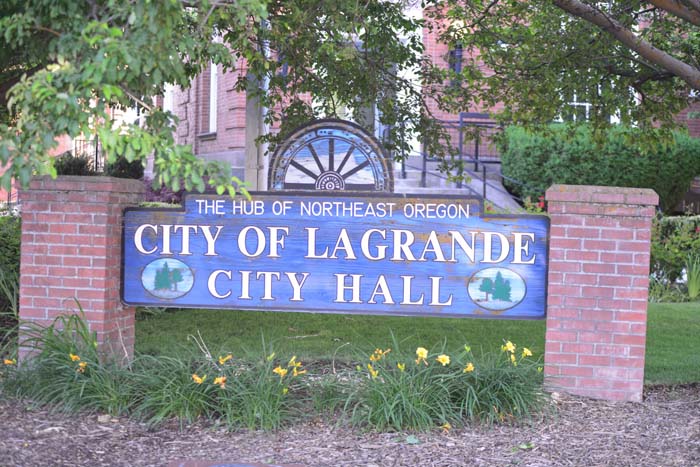Hugel Kultur for Gardening section
Published 6:00 am Wednesday, June 12, 2019

- A bee browses on a purple sensation allium in Cathy Mullins’ garden.
Cathy Mullins is in love with her hugel. The free-form raised bed winds through her flower garden, supporting a variety of blossoms and greenery, from teddy-bear sunflowers to sweet peas to alliums. “I am in love with flowers. Someday this will be just a riot of flowers and plants, a place where you can walk and discover all sorts of new things, edible things, plants and bees and birds, with a surprise around every corner,” she said.
“Hugelkultur” is a German term that means “mound culture” and has been practiced in northern Europe for hundreds of years. A hugel, says local naturalist Ralph Anderson, is a free-form raised bed constructed of natural materials—a foundation of decaying logs, covered by compost and other nutrients, plus soil. Under Anderson’s coaching, Mullins and her husband, Kimball Hawkins, gathered up a number of old logs, branches, and lumber, excavated a curving, elongate shallow trench, and stacked the wood of varying sizes there. Then they covered the logs, lumber, and branches with decomposing sod torn up from where the foundation for their new house was to be built. On top of that, they placed chicken manure from Hawkins Sisters and a mixture of grass clippings, straw, kitchen compost, and other organic matter. They topped it off with soil and a protective layer of weed-discouraging fabric.
Trending
“A hugel provides a lot of long-term nourishment for the plants,” Mullins said. “The logs and wood at the bottom hold moisture for a long time. Even when it’s dry in the summer, plants can derive both moisture and nutrients from the wood and the organic materials buried in the soil. The decomposing materials keep the soil warm so you have a slightly longer growing season.”
The free-form shapes of hugels are more creative than square raised beds. You could build a donut-shaped one, a long winding one, or one in the shape of a dinosaur. While not as efficient in design as traditional square, lumber-bound raised beds, hugels would seem to be more fun. Alder, cottonwoods, and poplars are good sources of wood to use, according to Anderson. They decay quickly underground, and retain lots of water for plants above them. Pines and other conifers are less desirable because the relatively high concentrations of tannins in their wood slow their decay and nutrient recycling and can retard growth of garden plants. It’s best to use logs that have already started to rot, as they will not absorb nitrogen needed by the plants growing in the soil you’ve placed above them.
For more information on hugels and hugelkulture, visit https://richsoil.com/hugelkultur/
Cathy planted the first bulbs and seeds in her hugel in 2016. Now, three years after the first plantings, the winding, sculpted mound is bustling with greenery and color. Along with sunflowers, alliums (onions) rank among Cathy’s favorite plants. “They are colorful, compact, and most importantly, the deer don’t eat them but the bees love them,” she said. Her favorite varieties include, Allium cristophii, or the Star of Persia which she has dubbed “purple fireworks” and the more common Allium aflatunense, or purple sensations. Star of Persia is a native of Turkmenistan, Iran, and Turkey that grows to a height of two feet and produces large rounded balls of small pinkish-purple flowers in late May to early June.
Mullin’s hugel is well on its way to becoming a pollinator garden. The alliums attract butterflies as well as bees. A little later in the year, a profusion of sweet peas will bloom. “They are really my favorites,” she said. “The flowers are fragrant and abundant, and the bees and butterflies love them. Plus, they are legumes, and further enrich the bountiful nutrients stashed in the hugel’s rich, organic soils.”









